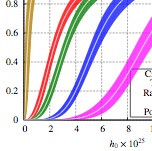Searches for gravitational waves from Sco X-1
 Sco X-1 is the brightest X-ray source (excluding the sun) in the sky, and
is potentially also the brightest source of continuous gravitational waves.
Chris Messenger
led a multi-year project aimed at determining the relative benefits of
a number of search algorithms that will likely be applied to
aLIGO data. The mock-data
challenge provided simulated data including signals at a range of strains,
and each algorithm then attempted to find the signals. Encouragingly, the
faintest detected signal is only a factor of two stronger than the estimated
torque balance limit, which indicates that this limit may be beaten with
improved algorithms, data, and also perhaps system parameter precision.
Sco X-1 is the brightest X-ray source (excluding the sun) in the sky, and
is potentially also the brightest source of continuous gravitational waves.
Chris Messenger
led a multi-year project aimed at determining the relative benefits of
a number of search algorithms that will likely be applied to
aLIGO data. The mock-data
challenge provided simulated data including signals at a range of strains,
and each algorithm then attempted to find the signals. Encouragingly, the
faintest detected signal is only a factor of two stronger than the estimated
torque balance limit, which indicates that this limit may be beaten with
improved algorithms, data, and also perhaps system parameter precision.
Read the paper (arXiv:1504.05889)
Labels: 2015, gravitational waves

